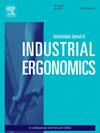Linking working memory capacity and response inhibition ability to driving behavior and eye movements in young novice drivers
IF 3
2区 工程技术
Q2 ENGINEERING, INDUSTRIAL
International Journal of Industrial Ergonomics
Pub Date : 2025-09-30
DOI:10.1016/j.ergon.2025.103814
引用次数: 0
Abstract
The weakness of cognitive control in young novice drivers may be a potential mechanism leading to road traffic injuries and fatalities among this group. While previous research has demonstrated the association of cognitive control with risky driving, the mechanism of cognitive control in driving and the role of eye movements in this relationship remain unclear. Therefore, the present study aims to clarify the theoretical framework of the relationships between two typical cognitive control capacities, namely working memory and response inhibition, with driving performance and eye movements. The goals are to determine when working memory capacity (WMC) and response inhibition ability (RIA) influence driving performance, to explore the possible interactive moderating effect between WMC and RIA, and to reveal the mediating effect of eye movements in the relationship between cognitive control and driving performance. During the experimental process, participants completed two WMC tasks (visuospatial working memory (VSWM), and verbal working memory (VWM)), an RIA task (cued go/no-go), and a simulated driving task (including car-following, pedestrian-crossing, etc.). Experimental data were obtained from 49 young Chinese novice drivers. The results showed that WMC and RIA significantly predicted overall driving performance, and stronger cognitive control leading to better driving performance in terms of the percentage of time spent over the speed limit (speeding), the standard deviation of the lateral position from the central line (SDLP), driving performance score, accident frequency, minimum time to collision (TTC), braking reaction time (BRT), and time to meet pedestrian (TMP). Moreover, WMC was found to moderate the relationship between RIA and driving performance. Specifically, WMC significantly predicted the driving performance score, accident frequency, and TMP for drivers with lower inhibitory control, and the WMC prediction of BRT was more pronounced for inattentive drivers. WMC was also found to predict eye movements, including vigilance (horizontal and vertical gaze variability) and effort level (pupil dilation). The relationship between WMC and driving performance was also found to be mediated by eye movements. Specifically, vertical gaze variability mediated the effects of VSWM on the driving performance score, accident frequency, and BRT, as well as the effects of VWM on BRT. Furthermore, pupil dilation mediated the effects of VWM on BRT. This study also discusses the potential mechanism of risky driving from the cognitive perspective, and improves the theoretical framework of “working memory–eye movement–driving performance.” Thus, this research is of theoretical and practical significance for driver safety training and risky driving intervention.
年轻新手驾驶行为和眼动与工作记忆容量、反应抑制能力的关系
年轻新手驾驶员的认知控制能力薄弱可能是导致这一群体道路交通伤害和死亡的潜在机制。虽然之前的研究已经证明了认知控制与危险驾驶之间的联系,但驾驶中的认知控制机制以及眼动在这种关系中的作用仍不清楚。因此,本研究旨在阐明工作记忆和反应抑制两种典型认知控制能力与驾驶表现和眼动之间关系的理论框架。目的是确定工作记忆容量(WMC)和反应抑制能力(RIA)对驾驶表现的影响,探讨WMC和反应抑制能力之间可能的交互调节作用,并揭示眼动在认知控制与驾驶表现关系中的中介作用。在实验过程中,被试完成了两个WMC任务(视觉空间工作记忆(VSWM)和言语工作记忆(VWM))、一个RIA任务(提示走/不走)和一个模拟驾驶任务(包括跟车、过马路等)。实验数据来自49名年轻的中国新手司机。结果表明,WMC和RIA对驾驶员整体驾驶表现具有显著的预测作用,在超速时间百分比(超速)、与中心线横向位置标准差(SDLP)、驾驶表现评分、事故频次、最小碰撞时间(TTC)、制动反应时间(BRT)和与行人相遇时间(TMP)等方面,认知控制能力越强,驾驶员的驾驶表现越好。此外,WMC还可以调节RIA与驾驶绩效之间的关系。具体而言,WMC对抑制控制较低的驾驶员的驾驶性能评分、事故频次和TMP的预测显著,而对注意力不集中的驾驶员的WMC对BRT的预测更为显著。WMC还被发现可以预测眼球运动,包括警惕性(水平和垂直凝视变化)和努力程度(瞳孔扩张)。WMC与驾驶表现之间的关系也被发现是由眼动介导的。具体而言,垂直凝视可变性介导了视距注视对驾驶性能评分、事故频次和快速反应时间的影响,以及视距注视对快速反应时间的影响。此外,瞳孔扩张介导了VWM对BRT的影响。本研究还从认知角度探讨了风险驾驶的潜在机制,完善了“工作记忆-眼动-驾驶表现”的理论框架。因此,本研究对驾驶员安全培训和危险驾驶干预具有一定的理论和现实意义。
本文章由计算机程序翻译,如有差异,请以英文原文为准。
求助全文
约1分钟内获得全文
求助全文
来源期刊
CiteScore
6.40
自引率
12.90%
发文量
110
审稿时长
56 days
期刊介绍:
The journal publishes original contributions that add to our understanding of the role of humans in today systems and the interactions thereof with various system components. The journal typically covers the following areas: industrial and occupational ergonomics, design of systems, tools and equipment, human performance measurement and modeling, human productivity, humans in technologically complex systems, and safety. The focus of the articles includes basic theoretical advances, applications, case studies, new methodologies and procedures; and empirical studies.

 求助内容:
求助内容: 应助结果提醒方式:
应助结果提醒方式:


